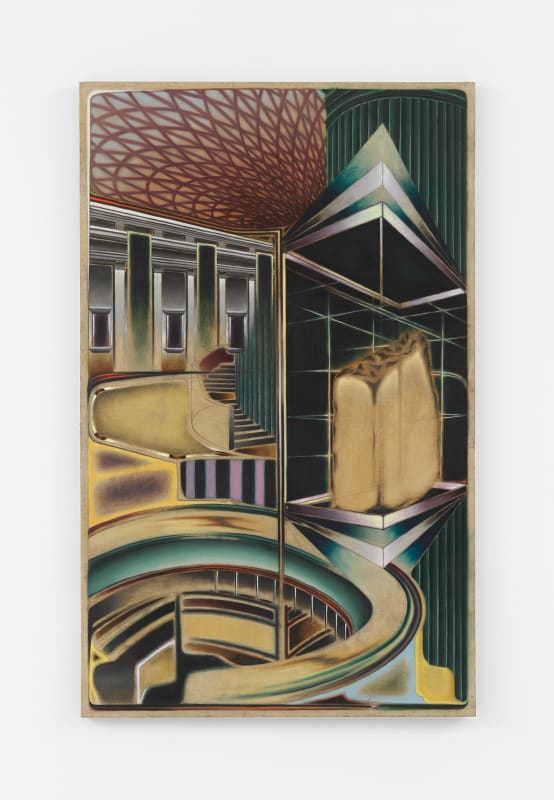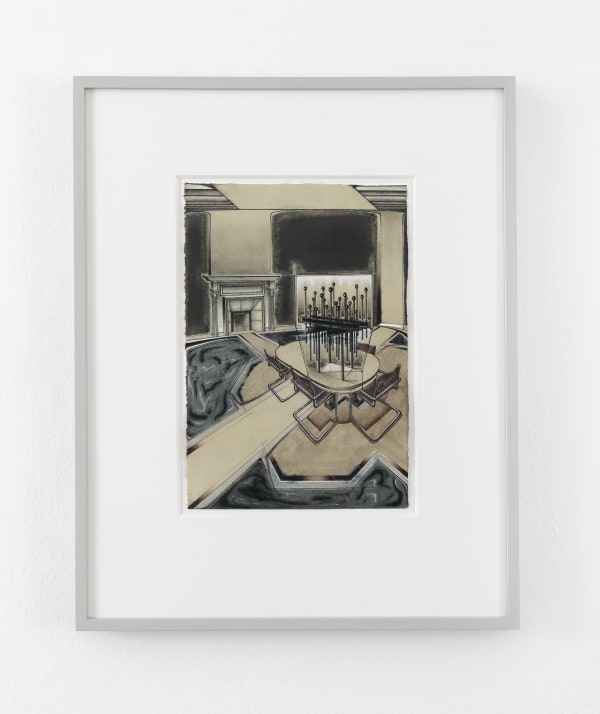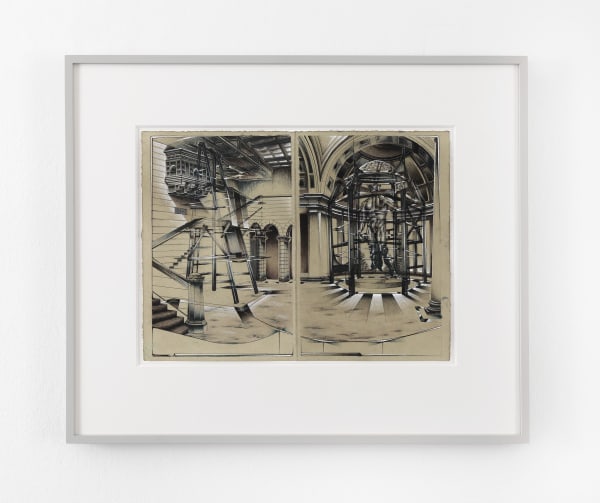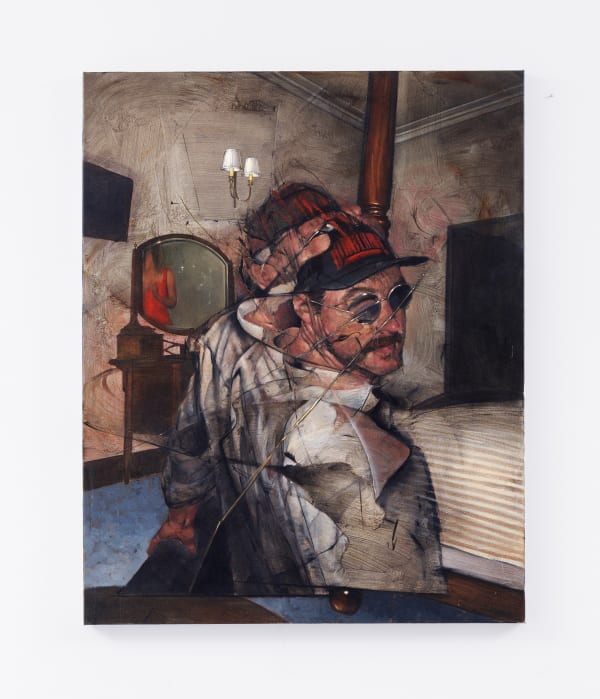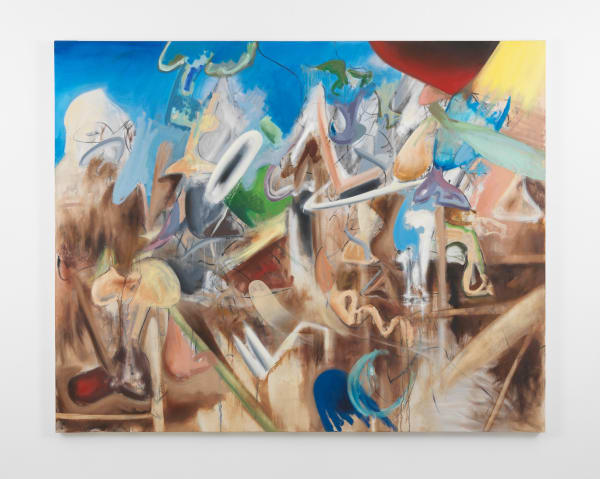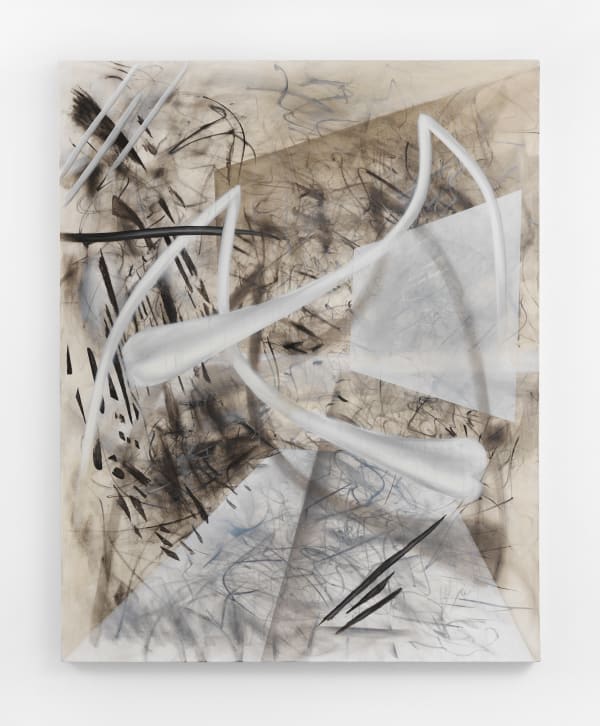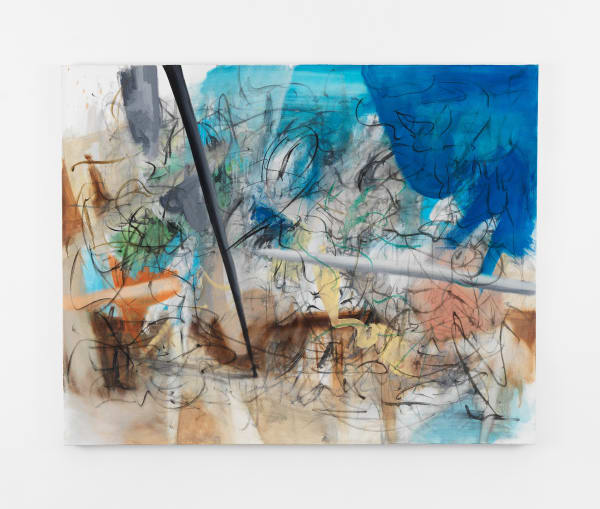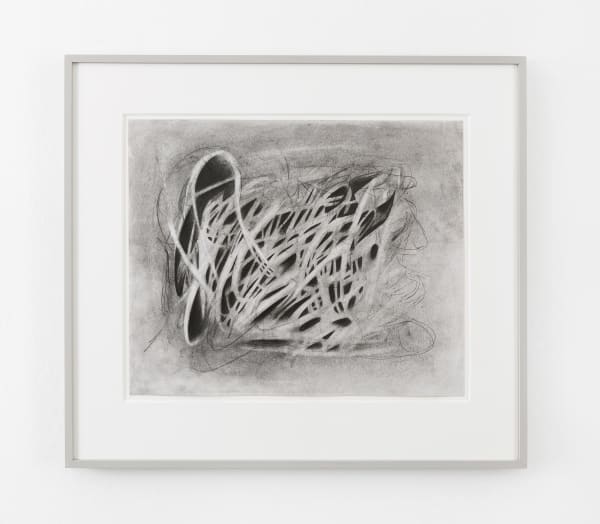Opening
Thursday, 20.02 at 5 – 7 PM
Through closed eyes, darkly
Space is a dominant organising principle that structures the way we experience the world around us. It plays out in the architectures that contextualise and inform embodied experience while also serving as a framework through which we arrange our inner lives. Our relationship to space is intimate, particular, and shaped as much by our psychology as our physicality.
Through closed eyes, darkly brings together three London-based artists who cultivate distinct treatments of space within their practices: Shane Keisuke Berkery, Julian Lombardi and Gus Monday. Referencing the Biblical idiom ‘through a glass, darkly’ and Phillip K. Dick’s 1977 novel A Scanner Darkly, the title of the exhibition describes how our perception of reality is imperfect and inevitably shaped by our own subjectivities. In paintings and works on paper, Berkery, Lombardi and Monday dissolve representational boundaries between internal and external experience, fusing autobiography and collective consciousness, sensation and observation, memory and encounter to explore how the complexities of human experience might be given form through artmaking.
For Gus Monday (b. 2000, London), architectural interiors serve as the environments for implicit narratives that play out through a series of coded proposals to the viewer. Public places, often with civic or bureaucratic functions, are meticulously rendered in oil on linen and ink on paper. The social codes of these spaces are implied through the particular characteristics and placement of furniture, flooring, staircases and sculptures, which obliquely enforce certain modes of operating within these settings. Unpopulated, they are left vacant for the viewer to project themselves into – to consider how the subtle directions proscribed by the arrangement of these architectures might shape the psychological and physical navigation of the environments we encounter.
Crucially, Monday does not present straightforward depictions of these spaces but rather brings to the fore the composite layers of history, lived experience and memory that permeate his settings. Amongst the deftly rendered elements of the rooms, areas of the canvas dissolve into loosely painted, amorphous swathes of paint or are left untouched, visualising the ways in which memory directs our attention; while some features are clearly articulated, as if held in the mind’s eye, others dissolve into the peripheries. Shaped both by subjective impression and the societal dynamics of public space, the paintings and drawings oscillate between utopian visions of civic life and dystopian spaces of critique and control.
The slippages between external and internal realities also inform the paintings of Shane Keisuke Berkery (b. 1992, Tokyo). For Berkery, painting is a vehicle through which he bridges inner-experience, the environments we inhabit and our relationship to images. The spaces that contain the action of his paintings are at once familiar and uncanny, populated with the accoutrement of contemporary life: bikes, televisions, kitchen cabinets and trainers. Yet through a painterly lyricism, Berkery works to conceal as much as he reveals, generating atmospheric scenes that question the (un)familiarity of the everyday and the uncanny in the mundane. Open doors and staircases lead to unseen spaces concealed beyond and, in one work, a pair of hands reaches in from the lower edges of the canvas – as if our own – to rest in shallow metal dishes connected to wires, the function of which is unclear.
In these paintings, meaning does not reside solely in the final image. Berkery is concerned with the way in which an image, first pictured in the mind, finds form on canvas through the physicality of painting. This is not an act of direct translation but a process of becoming in which meaning emerges through the laying down of brushstrokes – some carefully planned and others intuitive, residing in muscle memory and unconscious expression. Frequently interpreting other forms of visual representation within his own painterly language – from television screens to art-historical references – Berkery considers how our experience of the world is both shaped by and finds expression in our navigation of these visual sources, as well as the particularities of painting as a tool to conceptualise our deeply personal impressions of contemporary life.
Moving away from representations of actual places to the realm of internal impression, Julian Lombardi (b. 1996, Philadelphia) explores the spatialisation of psychological and sensory experience in abstract innerscapes. Gestural lines, protean forms and brightly coloured passages of paint commingle within abstracted spatial structures in which the principles of perspective play out. While some forms hurtle towards the viewer others recede into the recesses of the picture plane, visualising the way that personal experience collides and intersects with a multitude of influences: from global politics, collective consciousness and the technologies of the post-digital age to our embodied and psychological conditions. Gesturing back to art-historical legacies, surrealism becomes a mode of expression to access a nuanced relationship to the complicated present – an impetus particularly evidenced in the instinctive mark-making of the artist’s works on paper.
Tubular forms recur as a key motif across Lombardi’s work, directing the eye around the composition. They are suggestive of connective systems, skeletal or cable-like pathways that serve as communicative infrastructures or a means of transmitting information. Yet the routes of these systems are unresolved. They weave in and out of the other elements that populate these psychological landscapes, as if slipping between cognition and impulse, the individual and the collective, the conscious and the unconscious mind. Open, rather than prescriptive, the riotous environments they occupy are hybrid, multifaceted and in perpetual flux, mirroring our own contemporary condition of rupture and uncertainty.
In Through closed eyes, darkly, the three artists invite us to cross over the threshold of the painted surface and imaginatively inhabit the varied environments that unfold before us to reflect on the fundamental ways that conceptions of space inform our understanding of the contemporary human condition.
Kitty Gurnos-Davies, 2025
Julian Lombardi (b. 1996 in Philadelphia, USA) is an American artist living and working in London. Julian Lombardi has exhibited his work in several notable international exhibitions. In 2023 he presented "Heaven and Heathens" in Seattle, WA, followed by "Beautiful Little Rapture" in 2024 at The Something Machine in New York, where he will return for another solo exhibition in 2025. His recent group exhibitions include the 2024 Royal College of Art Painting MA Degree Exhibition in London, UK, and exhibitions at L.U.P.O in Milan, Italy, Bermondsey Project Space in London, UK, and Arusha Gallery in London, UK. He will also participate in group exhibitions at L.U.P.O in Milan, Italy, Chilli Arts Projects in London, UK, Belenius in Stockholm, Sweden, and Kearsey & Gold in London, UK in 2025.
Shane Berkery (b. 1992 in Tokyo, Japan) lives and works in London. He completed BA in Fine Art and History of Art at the National College of Art and Design in 2015 where Berkery first gained some national recognition through the college's censorship of his proposed degree show painting being reported in the Irish Times. The following year he was awarded the preeminent Hennessy-Craig award at the Royal Hibernian Academy. From then Berkery started having solo exhibitions nationally and abroad, exhibited work in the National Gallery of Ireland and entering works in to the state collection. In 2024 Berkery graduated from Painting MA at the Royal College of Art in London, concurrently exhibiting a large scale self portrait at the National Portrait Gallery. He will be exhibiting works in numerous exhibitions in 2025 in Singapore, Stockholm, London, Paris, and more.
Gus Monday (b. 2000 in London, UK) is a British, South African painter based in London. He graduated with a Foundation in Art and Design and a BA Hons (First Class) in Fine Art from The City and Guilds of London Art School, having been nominated for both The HARI Art Prize (2023) and the New Blood Emerging Artist Prize (2023). Monday graduated with an MA in Painting from the Royal College of Art and has exhibited internationally in South Korea, Spain and London. He currently has upcoming shows in London, Milan, Singapore, Stockholm and Seoul.
Photo: Per-Erik Adamsson
-
 Gus Monday, Turbine Hall, 2025
Gus Monday, Turbine Hall, 2025 -
 Gus Monday, The British Museum, 2025
Gus Monday, The British Museum, 2025 -
 Gus Monday, Sketch for Timothy Taylor, 2024
Gus Monday, Sketch for Timothy Taylor, 2024 -
 Gus Monday, Sketch for Accademia di Brera, 2024
Gus Monday, Sketch for Accademia di Brera, 2024
-
 Gus Monday, Sketch for Accademia di Firenze, Dome, 2024
Gus Monday, Sketch for Accademia di Firenze, Dome, 2024 -
 Shane Berkery, Study of a Figure in Space, 2024
Shane Berkery, Study of a Figure in Space, 2024 -
 Shane Berkery, Shoe Bearing Hand, 2024
Shane Berkery, Shoe Bearing Hand, 2024 -
 Shane Berkery, Ions, Pixels and Neurons, 2024
Shane Berkery, Ions, Pixels and Neurons, 2024
